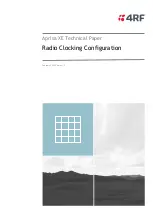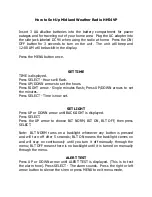
Appendix A. Glossary
Propagation:
The travel of a signal through a medium such as air or free
space.
Radio Frequency (RF):
Typically a frequency from 20 kHz to 100 GHZ. RF
is usually referred to whenever a signal is radiated through an enclosed
medium like a transmission cable or air.
Radio Modem:
An interface device used to encode the digital data from the
computer/datalogger into a protocol-defined, packetized, binary bit stream. The
encoded packets are sent to the radio and used to modulate the radio’s carrier
frequency, with the modem enabling the radio’s transmitter. In the receive
mode, the demodulated bit stream from the receiver is decoded and the digital
data is sent to the computer/datalogger. The RF500M and RF310M are radio
modems.
Radio Wave:
A combination of electric and magnetic fields varying at a radio
frequency and traveling through space at the speed of light.
Receiver Sensitivity:
The minimum signal level at the input to the receiver,
measured in volts or dBm, required to produces and output signal having some
specified measure of merit. The measure of merit is typically expressed in
terms of a minimum signal-to-noise ratio (SNR), SINAD, or a maximum bit
error rate (BER). The minimum received signal level required for reliable
communications.
Remote:
The end-of-link station interfaced with a co-located datalogger; which
is the source of the data to be communicated.
Repeater:
A station used to increase the line-of-sight coverage area or
transmission quality for an RF telemetry system. One or more repeater stations
can be intermediately located between the base station and one or more remote
stations for the purpose of relaying data in a store-and-forward process. A
repeater may or may not be interfaced with a co-located datalogger.
Received Signal Strength Indicator (RSSI):
An arbitrary indicator of the
received signal level, typically derived from a measurement of the total power
in the receiver’s IF bandwidth.
Signal-To-Noise Ratio (SNR):
A measure of the magnitude of a desired signal
relative to the magnitude of an undesired signal or noise.
SINAD:
The ratio of the total signal power level ( Noise + Distortion)
to unwanted signal power (Noise + Distortion) expressed in dB.
Spectrum:
A series of radiated energies arranged in order of wavelength. The
radio spectrum extends from 20 kilohertz upward.
Spectrum Analyzer:
An instrument that can be used to view signal amplitude
across a wide range of frequencies.
Spurious Emissions:
Unwanted radio frequency signals emitted from a
transmitter that sometimes causes interference.
Standing Wave Ratio (SWR):
The ratio of the amplitudes of the maximum
and minimum standing waves on a transmission line. Standing waves are
A-4
Summary of Contents for RF320 Series
Page 2: ......
Page 28: ...RF320 Series Ritron VHF UHF Radios 22 ...
Page 34: ...Appendix A Glossary A 6 ...
Page 35: ......





































